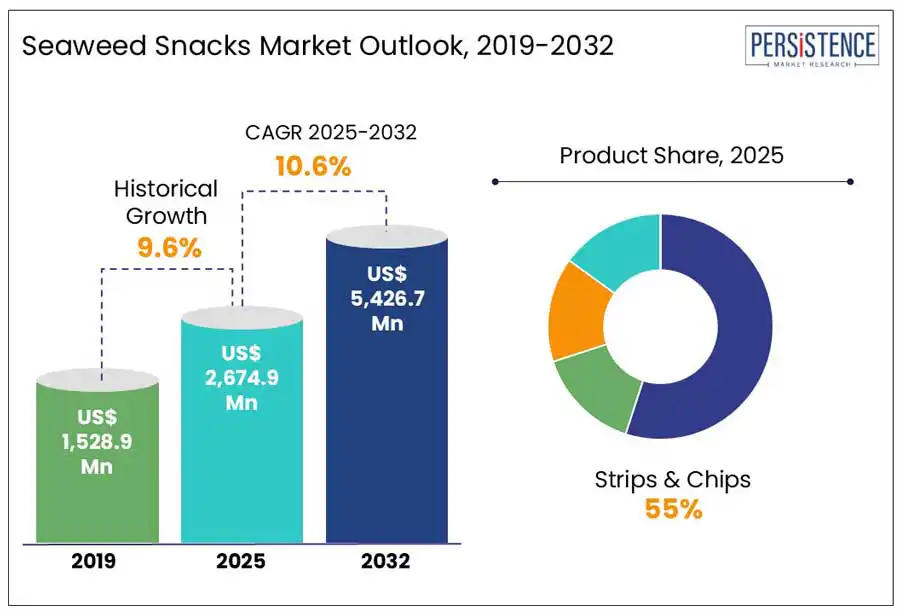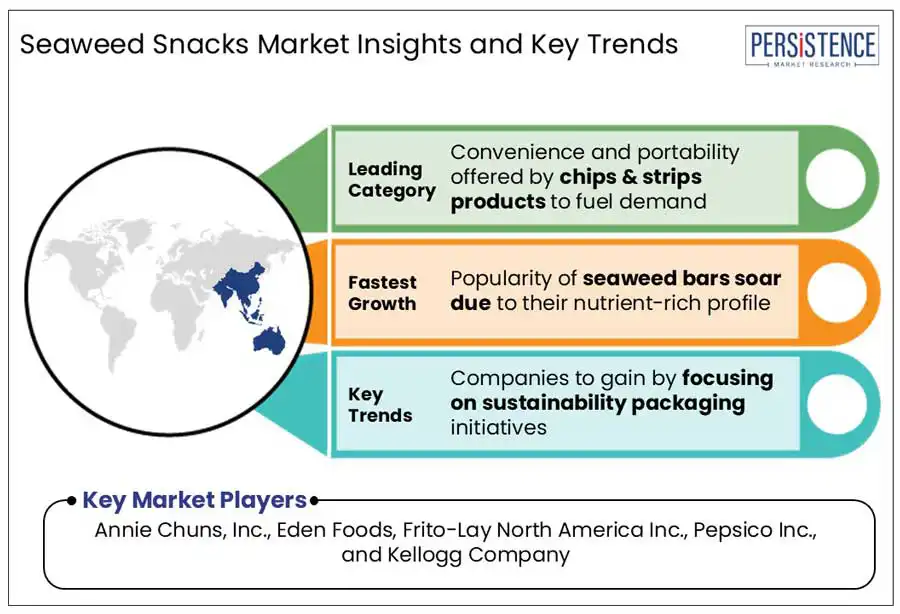Comprehensive Snapshot of Seaweed Snacks Market Report, Including Regional and Country Analysis in Brief.
Industry: Food and Beverages
Published Date: April-2025
Format: PPT*, PDF, EXCEL
Delivery Timelines: Contact Sales
Number of Pages: 130
Report ID: PMRREP35223
The global seaweed snacks market size is anticipated to be valued at US$ 2674.9 Mn in 2025. The market is projected to grow by US$ 5426.7 Mn between 2025 and 2032, at a CAGR of 10.6%. According to Persistence Market Research, growing consumer preference for healthier snack options, rising demand for vegan diets, and increasing popularity of Asian cuisine are factors driving the growth of the market.
Companies such as SeaSnax, gimMe, Taokaenoi, and Annie Chun are maintaining a stronghold in the market through product innovation, expanding flavor ranges, and leveraging clean-label marketing. Moreover, industry players are investing in sustainable sourcing and eco-friendly packaging, while strengthening distribution networks to stay competitive across both mainstream retail and health-focused outlets. Overall, the market outlook is likely to be positive and creates exciting growth opportunities during the forecast period.

Key Industry Highlights
|
Global Market Attribute |
Key Insights |
|
Seaweed Snacks Market Size (2025E) |
US$ 2674.9 Mn |
|
Market Value Forecast (2032F) |
US$ 5426.7 Mn |
|
Projected Growth (CAGR 2025 to 2032) |
10.6% |
|
Historical Market Growth (CAGR 2019 to 2024) |
9.6% |
Increasing prevalence of obesity and lifestyle-related diseases is driving people to adopt healthier eating habits, with a growing shift towards nutrient-rich, low calories snack options such as seaweed. As per studies, the total number of adults living with obesity is projected to increase by more than 115% between 2010 and 2030, emphasizing the need for adopting better dietary choices.
In line with this trend, growing awareness around weight management is pushing consumers toward snacks that support healthier lifestyles. Seaweed snacks, being naturally low in fat and calories, align well with calorie-conscious eating patterns. This shift is significantly visible among urban consumers who seek convenience without compromising health goals. With portion-controlled, easy-to-carry packaging, seaweed snacks are becoming a go-to for mindful snacking. This allows companies to maintain a stronghold by meeting the rising demand from health-conscious consumers.
Despite their health benefits many consumers hesitate to try seaweed-based products due to unfamiliar flavors, textures, and sensory attributes. For instance, a study involving consumers from Sweden introduced bread and spread products incorporating four different Northern European seaweed species. The findings revealed that while the overall acceptance was moderate the taste, flavor, and texture were the primary factors influencing consumer preferences. This suggests that unfamiliar sensory characteristics of seaweed can impact consumer acceptance, highlighting the need for product formulations that align with local taste preferences.
As sustainability continues to be a priority for consumers, there is a significant opportunity for companies to adopt eco-friendly and recyclable packaging solutions in the market. Many consumers are actively seeking brands that align with their environmental values. By using biodegradable, compostable, or recyclable packaging, companies can stay ahead of their competition. Besides, this not only reduces the environmental impact but also appeals to a growing segment of eco-conscious consumers.
Advancements in packaging technology are other factors that are leveraged by the industry players. By exploring innovations such as resellable plastic-free pouches, moisture-resistant packaging, or airtight seals, companies can improve the overall consumer experience while maintaining product quality. For instance, in November 2024, Gimme Seaweed partnered with rePurpose Global to enhance its sustainability initiatives. This collaboration was aimed at removing ocean-bound plastics in Indonesia and addressing plastic waste at its source. Such initiatives are likely to help companies appeal to environmentally aware consumers and distinguish themselves from competitors.
Based on the product, the market is segmented into strips & chips, flakes, bars, and others. Out of these, the strips & chips segment is anticipated to dominate and hold a share of about 55% in 2025. Both strips and chips are easy to eat on the go, which is gaining traction in today’s fast-paced, convenience-driven consumer environment. Their portability and bite-sized portions make them ideal for busy individuals looking for healthy yet convenient snack options.
On the other hand, the bars segment is projected to be the fastest-growing segment in the forthcoming years. Seaweed bars are rich in essential nutrients such as iodine, calcium, iron, vitamins A, C, and K. They also provide antioxidants, fiber, and omega-3 fatty acids. These bars are gaining popularity among health-conscious consumers globally. Besides, companies are focusing on introducing innovative seaweed bars as a popular snacking option, driving the segment’s demand through 2032. For instance, in July 2024, two students launched Phytabar, a vegan chocolate nutrition bar made from Wakame seaweed. These bars are packed with Omega-3s that help to improve mood and boost brain function.
Based on the distribution channel, offline segment is anticipated to register the largest revenue share during the forecast period. Consumers prefer in-store shopping for food items such as seaweed snacks because they can inspect the product, check the packaging, and sometimes even sample the product before making a purchase decision. Besides, countries such as Japan, South Korea, and Thailand have highly integrated traditional retail networks, which are anticipated to boost the adoption of the product through offline modes.
Online segment, on the other hand, is expected to be the fastest-growing segment, fueled by the growing trend of online shopping for convenience and increasing adoption of direct-to-consumer models globally.

Asia Pacific is projected to hold a share of about 52% in 2025 and is expected to dominate the market in the forthcoming years. The region’s deep-rooted cultural connection with seaweed as a dietary staple in countries such as Japan, South Korea, and China is fueling significant demand. Moreover, growing consumer demand for healthier snack alternatives, driven by a focus on clean, natural ingredients is expected to drive the growth of the market in this region.
China seaweed snacks market is anticipated to witness substantial growth during the forecast period. The country’s vast population and rapidly expanding middle class, combined with a strong cultural foundation in seaweed consumption, have made it the key market in the region. As the demand for healthy and convenient snacks continues to rise, consumers are increasingly turning to seaweed-based snacks due to their health benefits and low-calorie content. Additionally, China's thriving e-commerce platforms and retail sector have greatly facilitated the widespread availability of these snacks, making them accessible to a larger consumer base.
North America is projected to register steady growth from 2025 to 2032, driven by the increasing consumer preference for healthier and more natural snack options. As more people turn to low-calorie, nutrient-enrich snacks, seaweed products have gained significant popularity due to their high content of vitamins, minerals, and antioxidants. Additionally, the growing trend towards mindful eating and plant-based diets has made seaweed snacks an appealing choice for health-conscious individuals.
The U.S. seaweed snacks market is showing signs of explosive growth propelled by the convergence of health, environmental, and culinary trends. Consumers are increasingly seeking snacks that align with health-conscious and sustainable lifestyles, making seaweed snacks an attractive option. Moreover, companies are leveraging online channels to introduce innovative products such as seaweed chips, dried seaweed, and bars to cater to diverse taste preferences and dietary needs.
Europe is likely to witness considerable growth in the market, driven by evolving culinary preferences of consumers. Seaweed, a staple in many Asian countries, is becoming more mainstream as the trend of exploring different cuisines is taking precedence. The rising trend towards exploring fusion foods that blend traditional European ingredients with Asian flavors has opened up opportunities for seaweed snacks to appeal to broader consumer tastes. For instance, companies such as Eurasia L'Exotik Eat & Shop in France offer a range of seaweed-based products, catering to the increasing demand for ethnic flavors. Their product line includes seaweed snacks that blend traditional Asian ingredients with European tastes, highlighting the fusion cuisine trend in the region.
The global seaweed snacks market is experiencing substantial growth with companies actively forming partnerships and launching new products to meet growing consumer interest. Companies are focusing on expanding their production capacities, showcasing confidence in long-term demand. Moreover, in a bid to promote sustainability in the market, companies are focusing on raising investments to expand their regional presence and scale up manufacturing.
For instance, in September 2024, Notpla, a leading U.K.-based seaweed packaging startup, raised US$ 26 Mn in a Series A extension round led by United Bankers. The round also featured Temasek Trust’s Catalytic Capital for Climate & Health (C3H), along with existing investors. As per the company, the funding will aid in accelerating its presence in the U.S., while expanding its portfolio and scaling up manufacturing. Such initiatives showcase a competitive push by companies to capture market share and strengthen brand presence globally.
|
Report Attribute |
Details |
|
Historical Data/Actuals |
2019 - 2024 |
|
Forecast Period |
2025 - 2032 |
|
Market Analysis |
Value: US$ Mn |
|
Geographical Coverage |
|
|
Segmental Coverage |
|
|
Competitive Analysis |
|
|
Report Highlights |
|
|
Customization and Pricing |
Available upon request |
By Product
By Distribution Channel
By Source
By Application
By Region
To know more about delivery timeline for this report Contact Sales

The global market is projected to value at US$ 2674.9 Mn in 2025.
The market is driven by growing consumer demand for healthier, low-calorie snack options, the increasing adoption of vegan diets, and the rising popularity of Asian cuisine.
The market is poised to witness a CAGR of 10.6% from 2025 to 2032.
Increasing adoption of sustainable packaging solutions and rising demand for clean-label products are the key market opportunities.
Major players in the seaweed snacks industry include, Annie Chuns, Inc., Eden Foods, Frito-Lay North America Inc., Pepsico Inc., and Kellogg Company.